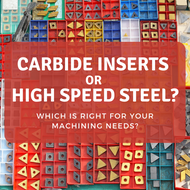Carbide Inserts vs. High-Speed Steel: Which is Right for Your Machining Needs?
Published by Kortney on May 22nd 2023
Carbide Inserts vs. High-Speed Steel: Which is Right for Your Machining Needs?
As a machinist, you know that choosing the right materials is crucial for getting the job done effectively and efficiently. The debate between carbide inserts and high-speed steel inserts is one that has been ongoing for years. Carbide inserts are known for their toughness, while high-speed steel inserts are renowned for their versatility. In this article, we'll explore the differences between these two materials to help you decide which one is right for your specific machining needs.
What are Carbide Inserts? Carbide inserts are a popular option in the world of machining, but what exactly are they? Simply put, carbide inserts are cutting tools that are made from a combination of carbide and a binding material. The resulting material is incredibly hard and durable, making carbide inserts a popular choice for tougher machining jobs. Carbide inserts are known for their ability to withstand higher temperatures and maintain their shape even under extreme pressure. They also offer excellent resistance to wear and tear, which means they last longer than other cutting tools. Many machinists prefer carbide inserts for their toughness and longevity, especially when working with harder materials like stainless steel or titanium. There are a few different types of carbide inserts, including coated and uncoated options. Coated carbide inserts have a thin layer of coating, which can improve their performance and lifespan even further. Uncoated options, on the other hand, may be more affordable but may not last as long or perform as well as coated options. Overall, carbide inserts are a reliable and popular choice for machinists who need a durable and long-lasting cutting tool. Their toughness, wear resistance, and high-temperature capabilities make them ideal for tougher machining jobs, and their versatility means they can be used in a variety of industries.
What are High-Speed Steel Inserts? High-speed steel inserts (HSS) are another option for machinists who need cutting tools that can handle tough materials. Unlike carbide inserts, HSS inserts are made from a type of steel that contains a high percentage of tungsten, which gives them their heat-resistant and hard-wearing properties. This allows them to maintain their shape and sharpness even when working with high-strength materials. HSS inserts are also known for their versatility, and can be used for a wide range of applications, including milling, turning and drilling. They are typically more affordable than carbide inserts, which can make them an attractive option for machinists who are looking to keep their costs down while still maintaining high performance. However, HSS inserts may not be the best choice for all machining needs. They may not be as effective when working with extremely tough materials, and they may not last as long as carbide inserts. Additionally, their lower hardness and wear resistance means they may need to be replaced more frequently than carbide inserts, which can add to costs in the long run. Overall, it is important to consider the specific requirements of your machining job when choosing between carbide and HSS inserts. While carbide may be the go-to choice for many machinists, HSS inserts may be a more cost-effective option for those who are working with less challenging materials or who need to keep their costs down. This brings us to the next section, cost-effectiveness.
Cost-Effectiveness However, when it comes to selecting the right insert, cost-effectiveness is often a top concern for many machinists. While carbide inserts are known for their durability and long-lasting performance, they also come with a higher price tag. On the other hand, HSS inserts are generally more affordable and may be a better option for those who are working with less challenging materials or who need to keep their costs down. Of course, it's important to keep in mind that cost-effectiveness shouldn't be the only factor you consider when choosing between carbide and HSS inserts. You'll also want to think about the specific requirements of your machining job and the level of precision and accuracy you need to achieve. With that said, for those who are working with more forgiving materials and looking to minimize costs, HSS inserts can be a versatile and budget-friendly option. That said, carbide inserts remain the go-to choice for many machinists who value their unmatched hardness, wear resistance, and overall performance. In the next section, we'll explore the versatility that carbide inserts offer and why they might be the better choice for certain applications.
Versatility For those who value versatility in their machining inserts, carbide is the way to go. Carbide inserts are known for their ability to handle a wide range of materials, from soft steels to high-performance alloys. They also come in a variety of shapes and sizes, making them suitable for virtually any application. Plus, carbide inserts can be used at high cutting speeds, which means that you can get the job done faster and more efficiently. Carbide inserts are particularly useful for roughing operations, where material needs to be removed quickly and efficiently. They are also ideal for machining hard and abrasive materials like cast iron and stainless steel, where HSS inserts may wear out quickly. In short, carbide inserts offer a level of versatility that is unmatched by HSS inserts. Of course, with great versatility comes a higher price tag. Carbide inserts are more expensive than HSS inserts, but they are well worth the investment if you need a versatile tool that can handle a wide range of materials and applications. In the next section, we'll explore the durability of carbide inserts and why they are the preferred choice for many machinists.
Durability When it comes to durability, carbide inserts reign supreme over high-speed steel. Carbide inserts are made from a combination of tungsten carbide and cobalt, which creates an incredibly hard and tough material that can withstand high temperatures and heavy cutting forces. This durability makes them ideal for long production runs where minimizing downtime is crucial. Unlike HSS inserts, which can become dull and require frequent sharpening, carbide inserts can last significantly longer. They may require occasional honing or replacement, but their long lifespan ultimately saves time and money in the long run. Additionally, carbide inserts typically have multiple cutting edges, which allows for continued use even as one edge becomes worn. This means less time spent changing out inserts and more time spent machining. In short, the durability of carbide inserts is a major advantage for machinists who value efficiency and productivity. Now, let's explore how carbide inserts compare in terms of ease of use.
Ease of Use Carbide inserts are known for their durability and ability to withstand the demands of high-speed machining. However, in addition to durability, ease of use is an important factor to consider when selecting a tool for your machining needs. One factor that makes carbide inserts easy to use is their versatility. They can be used in a variety of cutting applications and on a variety of materials, from soft aluminum to tough stainless steel. Additionally, carbide inserts can be sharpened or reconditioned, adding to their longevity and utility. Another advantage of carbide inserts is their consistency. Because they are manufactured to exacting standards and have a predictable cutting geometry, machinists can rely on them to produce consistent results with minimal setup time. This means less time spent on trial and error and more time spent on actual machining. Of course, like any tool, there is a learning curve to using carbide inserts effectively. However, once machinists become familiar with the tool and its capabilities, they will find that it is an easy and reliable choice for their machining needs.
In conclusion, carbide inserts offer many benefits beyond their durability, including versatility, consistency, and ease of use. While high-speed steel may be a viable option for some applications, carbide inserts are the clear choice for machinists who value efficiency and productivity in their work. Choosing between carbide inserts and high-speed steel inserts is a decision that must be made based on your specific machining needs. While carbide may offer greater durability and versatility, high-speed steel is more cost-effective and user-friendly. Ultimately, the right choice depends on a careful consideration of factors such as cost, purpose, and ease of use. By making the right decision, you can achieve your goals and succeed in your machining applications. As the saying goes, "The right tool for the right job makes all the difference." So take the time to assess your needs and select the tool that will help you reach your goals. Happy machining!
Click here to shop our selection of carbide inserts from top brands including Kennametal, Sandvik, Widia, Iscar and more!

